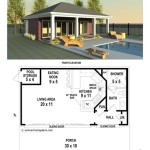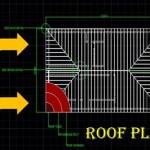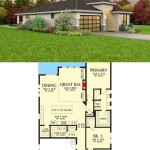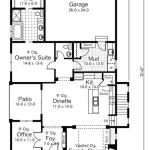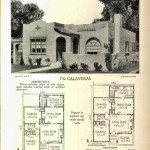Why Do Floor Plans Have Architectural Symbols?
Floor plans, at their core, are simplified graphical representations of a building’s layout, viewed from above and omitting the roof. They serve as essential communication tools within the architectural, engineering, and construction (AEC) industries. These plans aren't just freehand sketches; they are meticulously crafted diagrams that convey precise information about a building's dimensions, spatial relationships, and construction details. A crucial element contributing to this precision and clarity is the use of architectural symbols.
Architectural symbols are standardized, universally recognized graphical representations of various building components, materials, fixtures, and furniture. They allow architects, engineers, contractors, and other stakeholders to understand and interpret a floor plan quickly and accurately, regardless of their individual backgrounds or languages. Without these symbols, floor plans would be ambiguous, prone to misinterpretation, and ultimately, impractical for their intended purpose.
The use of architectural symbols ensures consistency and efficiency in the design and construction process. Instead of writing out lengthy descriptions for every door, window, or plumbing fixture, a simple symbol conveys all the necessary information in a compact and easily digestible format. This standardization significantly reduces the potential for errors and misunderstandings, contributing to smoother project workflows and cost savings.
Key Point 1: Facilitating Clear and Concise Communication
One of the primary reasons for employing architectural symbols on floor plans is to facilitate clear and concise communication among all parties involved in a building project. Consider the alternative: imagine a floor plan that relied solely on text descriptions to identify each element. Describing the type of door, its swing direction, dimensions, and material for every doorway in a building would be incredibly laborious and would clutter the drawing, making it difficult to read. Visual communication, especially through well-defined symbols, is significantly more efficient and less prone to misinterpretation.
Furthermore, the use of standardized symbols transcends language barriers. An architect in the United States can share a floor plan with a contractor in Europe, and both will understand the meaning of the symbols representing doors, windows, electrical outlets, and other essential elements, even if they don't speak the same language. This universality is vital in today's globalized construction industry, where projects often involve collaboration between teams across different countries and continents.
Architectural symbols also help streamline the review and approval process. Building officials and other regulatory agencies can quickly assess a floor plan to ensure it meets building codes and safety regulations, thanks to the standardized representation of key elements like fire exits, sprinkler systems, and accessibility features. This expedited review process contributes to faster project timelines and reduced administrative overhead.
Moreover, the visual nature of symbols allows for quick identification of potential problems or inconsistencies in the design. For example, an architect might quickly identify a conflict between the placement of a door and a load-bearing wall simply by visually inspecting the floor plan. This early detection of errors can prevent costly rework during the construction phase.
Key Point 2: Ensuring Accuracy and Precision in Design and Construction
Beyond communication, architectural symbols play a crucial role in ensuring accuracy and precision throughout the design and construction phases. These symbols are not arbitrary; they are carefully defined to represent specific types of building components and materials. The consistent use of these symbols ensures that the floor plan accurately reflects the intended design and that contractors can build the structure according to the architect's specifications.
For instance, different symbols are used to represent single-hung, double-hung, and casement windows. Each symbol conveys information about the window's operation and construction, allowing contractors to select the appropriate window type and install it correctly. Similarly, different symbols are used for various types of doors, such as interior doors, exterior doors, and fire-rated doors, each with its unique requirements for materials, hardware, and installation.
The precision conveyed by architectural symbols extends beyond individual building components. They also represent spatial relationships and dimensions. For example, the placement of a symbol for a sink or toilet in a bathroom floor plan indicates its exact location relative to walls, doors, and other fixtures. This precision ensures that the bathroom design is functional and complies with accessibility guidelines.
The use of architectural symbols also facilitates the creation of accurate construction documents. Floor plans are typically part of a larger set of drawings that include elevations, sections, and details. The consistent use of symbols across all these drawings ensures that all the information is consistent and that contractors have a complete and accurate picture of the building's design. This comprehensive documentation is essential for minimizing errors and ensuring the project is completed on time and within budget.
Furthermore, the precision afforded by symbols makes it easier to perform quantity takeoffs and cost estimations. Contractors can quickly count the number of doors, windows, and other components represented on the floor plan and use this information to estimate the cost of materials and labor. This accurate cost estimation is crucial for developing realistic project budgets and avoiding cost overruns.
Key Point 3: Maintaining Industry Standards and Promoting Efficiency
The standardization of architectural symbols is essential for maintaining industry standards and promoting efficiency across the AEC industries. Various organizations, such as the American National Standards Institute (ANSI) and the International Organization for Standardization (ISO), have established standards for architectural symbols that are widely adopted and recognized. These standards ensure that architects, engineers, and contractors are all using the same language and that floor plans are consistent and easily understandable.
The use of standardized symbols streamlines the design process by allowing architects to quickly create floor plans using pre-defined symbols. Instead of having to draw each component from scratch, they can simply insert the appropriate symbol into the drawing. This saves time and effort and allows them to focus on other aspects of the design.
Standardization also facilitates the use of computer-aided design (CAD) and building information modeling (BIM) software. These software programs have built-in libraries of architectural symbols that architects can easily access and use in their drawings. This integration with CAD and BIM software further enhances efficiency and accuracy in the design and construction process.
Moreover, the use of standardized symbols reduces the need for extensive training and education. Architects, engineers, and contractors are typically trained to recognize and interpret these symbols, allowing them to quickly understand floor plans and other construction documents. This reduces the learning curve for new professionals and ensures that everyone is on the same page.
The efficiency gained through the use of standardized symbols also translates to cost savings. By reducing errors, streamlining workflows, and facilitating communication, architectural symbols contribute to faster project timelines and lower construction costs. This makes building projects more affordable and accessible to a wider range of clients.
In addition to the benefits mentioned above, the evolution of architectural symbols reflects advancements in building technology and design practices. As new materials and construction techniques are developed, new symbols are created to represent them. This continuous evolution ensures that architectural symbols remain relevant and up-to-date with the latest industry trends.
For example, the increasing use of sustainable building materials and technologies has led to the development of new symbols representing solar panels, rainwater harvesting systems, and other green building features. These symbols allow architects to clearly communicate their sustainable design intent and ensure that these features are properly integrated into the building's design.

15 Key Floor Plan Symbols 74 Architectural Abbreviations Foyr

10 Types Of Floor Plan And Blueprint Symbols

10 Types Of Floor Plan And Blueprint Symbols

Need To Know Floor Plan Symbols Evertise

Sample Sesyd Data Synthetic Architectural Floor Plan A And Scientific Diagram

15 Key Floor Plan Symbols 74 Architectural Abbreviations Foyr

10 Types Of Floor Plan And Blueprint Symbols
:format(webp)?strip=all)
How To Read Floor Plan Symbols

15 Key Floor Plan Symbols 74 Architectural Abbreviations Foyr

Architectural Symbols To Remember For Architects
Related Posts


